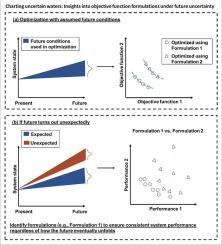绘制不确定的水域:对未来不确定性下目标函数公式的见解
IF 3.1
Q2 GEOSCIENCES, MULTIDISCIPLINARY
引用次数: 0
摘要
由于未来条件的不确定性,水资源的最佳管理具有挑战性。一种有希望的方法是直接将未来的不确定性纳入优化问题的目标函数公式,从而实现跨多种潜在条件的系统性能评估。然而,这产生了额外的不确定性,因为目标函数公式的选择和优化中包含的可能的未来条件都是主观的。考虑到在可能的未来条件中固有的不确定性,优化中包含的未来条件几乎不可能涵盖所有可能发生的条件。因此,无论未来的不确定性如何,确定表现良好的目标函数公式至关重要;然而,它还没有被正式探讨。在这项研究中,不同的目标函数公式在预期(即,类似于优化中使用的条件)和意外(即,与优化中使用的条件大不相同)的未来条件下的性能通过现实世界的案例研究进行了调查。结果表明,在预期和意外条件下,百分位数和期望值的公式通常表现一致,而基于极端情况的公式可能导致高度可变的结果,这取决于未来将实现的实际条件。最后,基于方差的配方在所有条件下都提供了最大的一致性,但在有利条件下可能导致性能受损。本文章由计算机程序翻译,如有差异,请以英文原文为准。

Charting uncertain waters: Insights into objective function formulations under future uncertainty
Optimal management of water resources is challenging due to uncertainty in future conditions. One promising approach is to directly incorporate future uncertainty into objective function formulations of optimization problems, enabling system performance evaluation across multiple potential conditions. However, this creates additional uncertainties as both the choice of objective function formulation and the plausible future conditions included in optimization are subjective. Given the inherent uncertainty in plausible future conditions, it is highly unlikely that future conditions included in optimization can cover all conditions that might occur. Therefore, identifying objective function formulations that perform well regardless of future uncertainties is crucial; however, it has not been formally explored. In this study, the performance of different objective function formulations under both expected (i.e., similar to conditions used in optimization) and unexpected (i.e., vastly different from conditions used in optimization) future conditions is investigated using a real-world case study. Results reveal that percentile and expected-value-based formulations generally perform consistently under both expected and unexpected conditions, whereas extreme-case-based formulations can lead to highly variable results depending on the actual conditions that will be realized in the future. Finally, variance-based formulations offer the greatest consistency across all conditions but may lead to compromised performance under favorable conditions.
求助全文
通过发布文献求助,成功后即可免费获取论文全文。
去求助
来源期刊

Journal of Hydrology X
Environmental Science-Water Science and Technology
CiteScore
7.00
自引率
2.50%
发文量
20
审稿时长
25 weeks
 求助内容:
求助内容: 应助结果提醒方式:
应助结果提醒方式:


